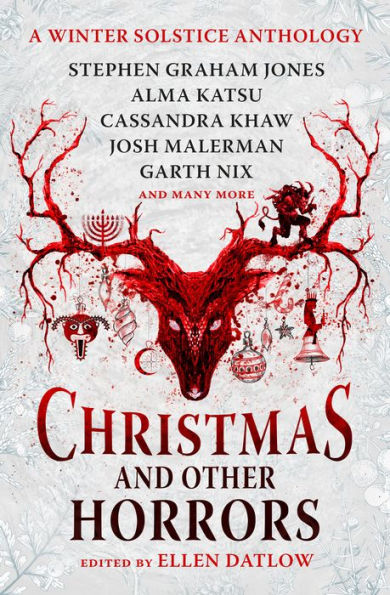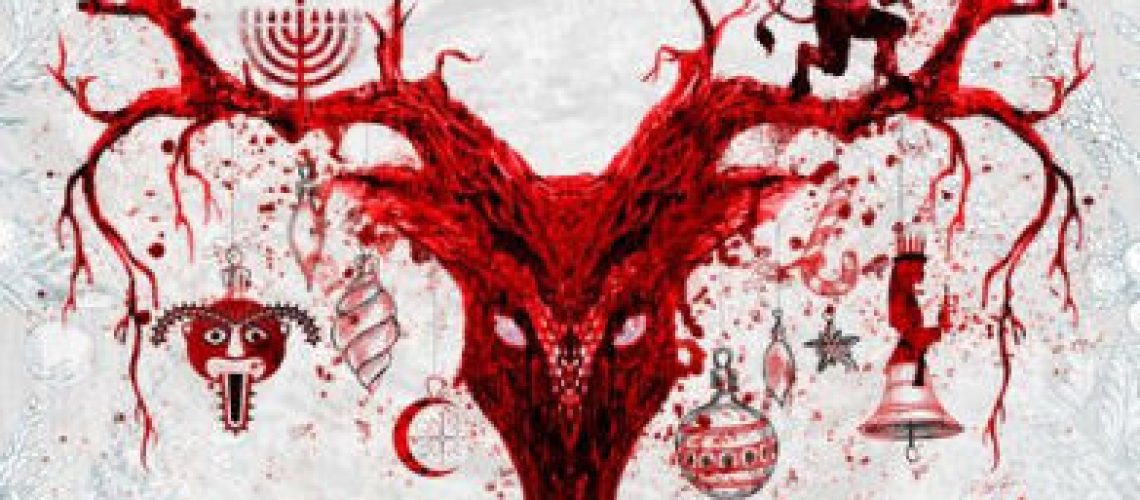If general holiday dark fantasy is something that you are in the mood to nestle into this time of the year, Ellen Datlow’s latest themed collection of all-original content, Christmas and Other Horrors, serves as a perfect dose of solstice creepiness and disquiet. It’s not conventionally Christmas focused, and it offers a diverse selection of current horror writers and styles.
Anthologies can often tend to be mixed affairs, whether in film or book form, particularly for casual viewers/readers or someone who only likes particular styles of writing or subgenres. This collection is no exception, offering a lot of potential things to enjoy, but probably leaving most readers with clear favorites, some middling reads, and a few that just don’t connect even if well composed. I imagine most are familiar with Datlow as a prolific and beloved editor, and with the generally excellent job she does with selection and curating of anthologies. And most genre fans probably already recognize and know most, if not all, of the contributors here. But, if you’re not sure what you’d be in for with that information, it’s best to just give this a try, particularly if this solstice horror theme suits you.

And solstice is really the key thematic element here, more than the title’s focus on Christmas. True, several of the stories here mention Christmas, and a few paint a darker look at the actual Christian holy day (rather than its ubiquitous secularized form.) There’s also inclusion of stories focused on the other celebrations of the season, Hanukkah, Kwanzaa, and even Festivus. But the majority (even those that might be set around Christmas) are really about solstice, that moment when the sun stops on its journey across Earth’s skies to change course. As many traditions of modern Christmas celebration are really appropriation and secularization of more ancient pagan festivities, several stories could be seen from either or combined perspectives.
The cover of the book describes this as “A Winter Solstice Anthology,” but I’ve also seen subtitles for it as “An Anthology of Solstice Horror.” The latter would be most accurate; I’d offer an edit to the cover to change it to “A December Solstice Anthology.” Most stories in the collection are set during the Northern Hemisphere’s winter, when December 21st brings the longest night of the year. But, some offerings from Australia reminds us that this time is summer in the Southern Hemisphere, when the solstice brings the shortest night of the year.
I’m going to say a little bit about each and every story here now, in their order of appearance within the anthology. If you want to skip over all such detail, head on to the end for my conclusion and a complete list of the table of contents for the collection. Each story is followed by a short note by its author that describes how they came up with the story or choose the ideas they featured. I didn’t mind these, but in general I wished most would’ve been a little longer and more detailed if they were to be included. More information on all the authors is included in an appendix.
Christmas and Other Horrors starts strongly from the gates with a trio of stories that set the thematic stage and creep the reader out without being too demanding for careful attention. The first story by Christopher Golden features the Austrian folklore of the Schnabelperchten. It has probably the most gore and monster-style horror of the anthology, but also has some nice social commentary beneath it all. Benjamin Percy writes the next story as a darker take on the origin of Santa’s toy-making elves and Alma Katsu follows that with a story set in Wales about a wassailing folk custom known as Mari Lwyd turned darkly, again serving as a bit of social commentary as well.
Terry Dowling’s “The Malkin Field” takes us to the Summer Solstice for the first time in the collection, while also switching gears to a more nuanced tale of dread featuring a man who happens to notice a refrigerator in the middle of a field, meets the two siblings who own the land, and hears a story about their missing father, a scarecrow, and the distant trees. The next story, by Nick Mamatas, deals with a Greek Orthodox tradition of blessing the waters of Long Island Sound, and what might happen from a surprise family visit during holiday time. It relies less on the kind of unsettling atmosphere that Dowling’s preceding story did, and instead goes for a twisted bit of a surprise ending.
Glen Hirshberg’s offering features a traditional visit by three generations of Jewish women to a sculpture garden that the grandfather dedicated his life and spirit into building. He asked that after his death that they return to the sculptures this time of year to write and deposit little notes into the mouths of his hollow creations. Though they dislike and resent this tradition, they keep it up, fearful of what might happen if they were to stop. Where the previous story by Percy took the Christian legend of St. Nicholas (and subsequent Santa Claus traditions) and filtered things through a darker lens, I found this story by Hirschberg interesting in how well it conveyed a darker take on themes of Hanukkah while also addressing the ties of family and culture that go beyond religion proper.
Tananarive Due’s “Return to Bear Creek Lodge” does something similar by looking at the darker sides of themes of Kwanzaa. The holiday is meant to be a celebration of community and unity, of family, for those who came (or were taken) from Africa. There are lots of great things about unity, community, and family. But there are also some not great things that can come along with it, such as intergenerational trauma. Due’s story is a powerful one that looks unflinchingly at this. Though the story works great on its own, it’s apparently a sequel to a previous story she has written, and I’m eager to check it out now. It’s one of the stand-out stories of the collection. Where Hirshberg’s treatment of similar themes went into a plot that plodded a bit and could’ve been condensed, every bit of Due’s story worked here, with excellent pacing, nice shots of horror, and a compelling underlying theme.
Separating Hirshberg’s and Due’s tales is a shorter story by Garth Nix that again slips us down to the Summer Solstice. I usually enjoy Nix’s work. While I found the premise of his offering here interesting, its stylized content of mostly dialogue just did not work for me. The selection after Due’s is “The Ghost of Christmases Past” by Richard Kadrey, with a woman whose brother was eaten by a monster at Christmas and who has lived with that trauma since, trying to avoid the same fate. While the direction of this story first appears straight-forward, well played surprises are in store.
Stephen Graham Stone’s story follows and represents a well written piece that on its surface is about a man walking his dog through the neighborhood and witnessing what might be a monstrous woman who can remove her head through the windows of a home he passes. But, there’s also clearly a lot going on here under the surface, and it’s a story I need to reread more carefully again to clarify. The next story by Nadia Bulkin is the one that features Seinfeld‘s Festivus, with its “traditional” airing of grievances and feats of strength. There can’t help but be some humor in this, even with the darker tones of the story. Mostly Bulkin’s story worked for me in the familiarity of holiday gatherings among found family when one is younger and in school, compared to how you then view those relationships later in life.
“Löyly Sow-na” by Josh Malerman comes next, one of my favorite selections from the anthology. There is a continuous line of unease that runs through the story of a young man meeting his Finnish fiancé’s father during a moment of intense physical and psychological vulnerability within a sauna. But rather than going full darkness, the story takes ancient traditions and ends up infusing things with more hope than dire despair, a nice breath from what dominates the rest of the anthology.
Despair, however, returns in Cassandra Khaw’s apocalyptic “Cold”, a tale that I appreciated for its approach to apocalyptic fiction in in its traditional, literal sense. While I didn’t find the plot strongly engaging, I really enjoyed Khaw’s writing here and how it brought the tone of the story’s themes alive.
For the next two stories, by Kaaron Warren and Jeffrey Ford, I was feeling a bit of fatigue. Drifting, they didn’t really capture my enjoyment as much as those immediately preceding or following. Warren’s story features a blending of reality TV show culture, cooking artistry, beauty contests, and pagan traditions. Ford’s revolves around a tradition of moral responsibility in aiding anyone who comes to your door in need over the Christmas holiday. Like all the stories in the anthology, these seem to have arisen from one particular idea that then got fleshed out. I didn’t happen to find either captivating, but that could easily change if I reread them again later. I have heard others really enjoyed them, and hey, that’s the nature of anthologies.
Finally, the collection concludes with three tales I really enjoyed, despite being very different kinds of stories. M. Rickert’s reads almost like an episode of The Twilight Zone, where a simple tradition of upsetting the adult-child power balance turns particularly badly for one woman. Gemma Files’ “No Light, No Light” almost seems out-of-place in this anthology, a piece of eco-horror fiction that nonetheless does concern the Solstice. It’s just so different than anything else in the book. That could turn some off, but I found it a refreshing changeup with all of the technical geologic details that went into as well. To end things, we have another offering that is quite different, an erotic piece of fiction by John Langan with post-coital (and pre-coital) discussions between three subsequent rounds of sex. From the discussion the reader begins to see that something is not quite right here, in ways that end up very nicely tying together with the solstice theme.
There is such huge amounts of variety to Christmas and Other Horrors that I can easily see many readers dismissing it as inconsistent or mostly average. This is an anthology where you really do have to be open to reading a wide range of dark fantasy and horror, either because you want to discover more or you already are a generalist for your enjoyment. I’d say that most of the stories tend more towards dark fantasy than horror that aims for being graphic or trying to outright scare. I would recommend reading this a small bit at a time, perhaps one story a day or a few a week. I read this quickly in just a couple sittings for the purposes of this review, but I know I will find more to dig into and enjoy within the stories, particularly those that were more nuanced in their complexity.
Contents:
“The Importance of a Tidy Home” by Christopher Golden
“The Ones He Takes” by Benjamin Percy
“His Castle” by Alma Katsu
“The Mawkin Field” by Terry Dowling
“The Blessing of the Waters” by Nick Mamatas
“Dry and Ready” by Glen Hirshberg
“Last Drinks at Bondi Beach” by Garth Nix
“Return to Bear Creek Lodge” by Tananarive Due
“The Ghost of Christmases Past” by Richard Kadrey
“Our Recent Unpleasantness” by Stephen Graham Jone
“All The Pretty People” by Nadia Bulkin
“Löyly Sow-na” by Josh Malerman
“Cold” by Cassandra Khaw
“Gravé of Small Birds” by Kaaron Warren
“The Visitation” by Jeffrey Ford
“The Lord of Misrule” by M. Rickert
“No Light, No Light” by Gemma Files
“After Words” by John Langan







